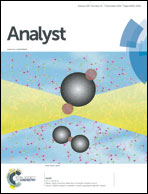HPLC-MRM relative quantification analysis of fatty acids based on a novel derivatization strategy†
Abstract
Fatty acids (FAs) are associated with a series of diseases including tumors, diabetes, and heart diseases. As potential biomarkers, FAs have attracted increasing attention from both biological researchers and the pharmaceutical industry. However, poor ionization efficiency, extreme diversity, strict dependence on internal standards and complicated multiple reaction monitoring (MRM) optimization protocols have challenged efforts to quantify FAs. In this work, a novel derivatization strategy based on 2,4-bis(diethylamino)-6-hydrazino-1,3,5-triazine was developed to enable quantification of FAs. The sensitivity of FA detection was significantly enhanced as a result of the derivatization procedure. FA quantities as low as 10 fg could be detected by high-performance liquid chromatography coupled with triple-quadrupole mass spectrometry. General MRM conditions were developed for any FA, which facilitated the quantification and extended the application of the method. The FA quantification strategy based on HPLC-MRM was carried out using deuterated derivatization reagents. “Heavy” derivatization reagents were used as internal standards (ISs) to minimize matrix effects. Prior to statistical analysis, amounts of each FA species were normalized by their corresponding IS, which guaranteed the accuracy and reliability of the method. FA changes in plasma induced by ageing were studied using this strategy. Several FA species were identified as potential ageing biomarkers. The sensitivity, accuracy, reliability, and full coverage of the method ensure that this strategy has strong potential for both biomarker discovery and lipidomic research.


 Please wait while we load your content...
Please wait while we load your content...